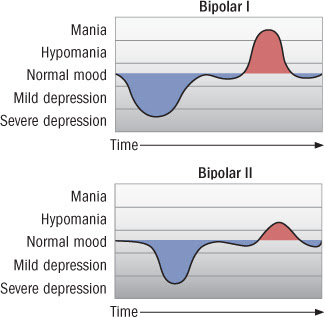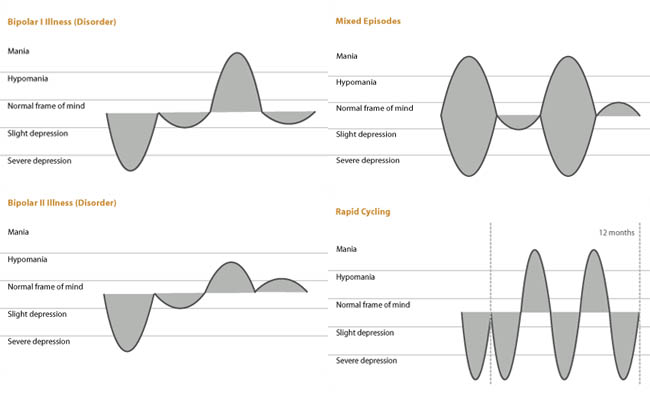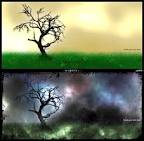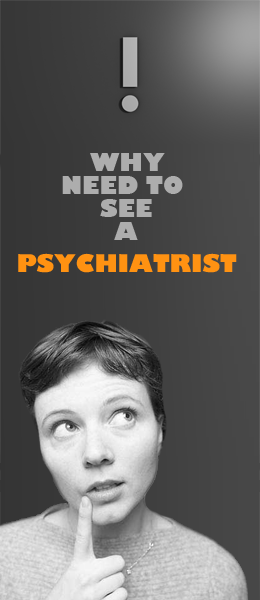BIPOLAR DISORDER
Bipolar disorder is a chronic (long-term) condition where you have periods of depression ('lows') and periods of mania or hypomania ('highs').treatment with 'mood stabilisers' or anticonvulsant medicines aims to keep your mood within normal limits.
What is bipolar disorder?
Bipolar disorder is sometimes called manic depression or bipolar affective disorder. In this condition you have periods where your mood is in one extreme or another:
- One extreme is called depression, where you feel 'low' and have other symptoms.
- The other extreme is called mania, where you feel 'high' or elated along with other symptoms.
The length of time that the patient spends in each extreme can vary. It is usually for several weeks at a time or longer. Bipolar disorder is very different from the mood swings that moody people have which last a few minutes or hours.
You can have any number of episodes of highs and lows throughout your life. In between episodes of highs or lows there may be gaps of weeks, months or years when your mood is normal. However, some people swing from highs to lows quite quickly without a period of normal mood in between. This is called 'rapid cycling'. (If you have the rapid cycling form of the condition you have at least four mood swings per year.)


Who gets bipolar disorder?
The disorder occurs between 1-2 in a 100 people. It can occur at any age, but most commonly first develops between the ages of 17 and 29. It occurs with same frequency in men and women.
What are the symptoms of mania and hypomania?
Mania causes an abnormally 'high' or 'irritable' mood which lasts at least one week - but usually lasts much longer than this. It can develop quite quickly - over a few days or so. During the 'high' period you will usually have some of the following:
- Grand ideas about yourself and your own self-importance.
- Increased energy.
- Need less sleep than usual.
- Be more talkative than usual. You tend to talk quickly.
- 'Flight of ideas'. You tend to change quickly from one idea to another. You may feel as if your thoughts are racing.
- Easily distracted
- Full of new ideas and plans. Often the plans are grandiose and unrealistic.
- Irritation or agitation, particularly with people who do not seem to understand your 'great' ideas and plans. Sometimes this can make you aggressive towards people.
- Wanting to do lots of pleasurable things.
For example, you may: - Spend a lot of money (which you often cannot afford).
- Be less inhibited about your sexual behaviour.
- Make rash decisions, often on the spur of the moment. These can be about jobs, relationships, money, health, etc, and are often disastrous.
- Take part in risky 'exciting' adventures.
- Drink a lot of alcohol, or take illegal drugs.
Severe mania may also cause 'psychotic' symptoms where you lose touch with reality.
Usually, you do not realise that you have a problem when you are high. But, to others your behaviour can be bizarre. Family and friends tend to be the ones who realise that there is a problem. But, if someone tries to point out that you are behaving oddly, you tend to become irritated.
If mania is not treated, the bizarre and uninhibited behaviour may cause great damage to your relationships, job, career and finances. When you recover from an episode of mania you often regret many of the things that you did when you were high.
Hypomania is the term used when you are high, but the symptoms are not as severe or extreme as in true mania. You may function quite well if you have hypomania. For example, you may just appear to be full of energy, the 'life and soul' of the party, work too much, but find it difficult to 'switch off' and relax. However, you are still at risk of making rash and dangerous decisions. Family and friends will recognise that you are not your normal self.
What are the symptoms of depression?
The word depressed is a common everyday word. People might say "I'm depressed" when in fact they mean "I'm fed up because I've failed an exam, or lost my job", etc. These ups and downs of life are common and normal.
With true depression, you have low mood and other symptoms each day for at least two weeks. Symptoms also become severe enough to interfere with day-to-day functions. Symptoms of depression are:
- Low mood for most of the day, nearly every day.
- Loss of enjoyment and interest in life.
- Abnormal sadness, often with weepiness.
- Feeling guilty, worthless, or useless.
- Poor motivation
- Poor concentration. It may be difficult to read, work, etc.
- Sleeping problems:
- Sometimes difficulty in getting off to sleep.
- Sometimes waking early and unable to get back to sleep.
- Sleeping too much sometimes occurs.
- Lacking in energy, always feeling tired.
- Difficulty with affection.
- Poor appetite and weight loss. Sometimes the reverse happens with comfort eating and weight gain.
- Being irritable, agitated, or restless.
- Physical symptoms such as headaches, palpitations, chest pains, and 'aches and pains'.
- Recurrent thoughts of death. This is not usually a fear of death, more a preoccupation with death and dying. Some people get suicidal ideas - "life's not worth living".
Some people do not realise when they develop depression. Some people think that they have a physical illness; for example, if they lose weight.
How is bipolar disorder diagnosed?
If you have symptoms of mania, often you do not realise that there is anything wrong and it is your friends or family who are the ones that can see that you are not your usual self. They may encourage you to see your doctor who can usually diagnose an episode of mania from your typical symptoms and the way that you are behaving.
If you go to see your doctor because you have an episode of depression, it can be a little bit more difficult to diagnose bipolar disorder. Bipolar disorder commonly is under diagnosed in people who see a doctor because of depression.
What is the usual outcome of the condition?
Bipolar affective disorder is a lifelong condition. Some general points include the following:
Without treatment
- The average length for an episode of mania is months. But for some people it can last much longer.
- Some people's mood recovers completely between episodes of mania or depression. In others, their mood does not completely recover.
- The average length for an episode of depression is six months but, again, it can be longer.
- You cannot predict how often episodes of mania and depression will occur:
- After recovering from a mood episode, a further episode of mania or depression occurs within one year in about half of cases. Within four years, 3 out of 4 people will have had another episode.
- Some people only ever have one episode of mania for a few weeks or months.
- About 1 in 6 people with bipolar disorder have the rapid cycling form of the condition.
- As time goes on, the time period of 'normal' mood between episodes of mania or depression tends to get shorter. Also, episodes of depression tend to become more frequent and last for longer.

So, some people have more frequent and severe episodes than others. Because of the nature of the condition, your chance of holding down a job is less than average. Relationships can be strained. Also, you have an increased risk of suicide if depression becomes severe, and an increased risk of death from risky adventures during an episode of mania. The outlook is worse if you take street drugs or drink a lot of alcohol.
With treatment
The course, pattern and outlook of the condition can be improved. However, there is no once and for all 'cure'. Treatment usually means that episodes of mania or depression are shorter and/or may be prevented.
What is the treatment for bipolar affective disorder?
Treatments include:
- Medicines that aim to prevent episodes of mania, hypomania and depression. These are called 'mood stabilisers'. You take these every day, long-term.
- The treatment of depression in people with bipolar affective disorder is similar to that for people who develop depression without episodes of mania:
- Antidepressants work well to relieve symptoms.
- A normal course of antidepressants is for six months or more after the symptoms of depression have eased. If you stop them too soon the depression may quickly return.
- Regular exercise may also help to ease symptoms of depression.
Family and friends
Episodes of mania or depression can be distressing for family and friends; particularly, a first episode of mania. Bizarre and odd behaviour in a close relative or friend, which is out of character, can cause a lot of upset.
Once you know the diagnosis, you may then understand that odd behaviour of your friend or loved one is due to mental illness. People with mania usually do not realise they are ill. So, family and friends are often of great help in alerting a doctor or other healthcare worker if symptoms of a new episode of illness develop. Also, try to encourage the affected person to take their medication as prescribed and also to try the 'self-help' measures listed above. Support groups may also provide support for family and carers.

 BIPOLAR DISORDER
BIPOLAR DISORDER

